Abstract
An apparently completely complement C7-deficient patient with refractory otitis media and two episodes of meningococcal disease was given therapeutic plasma transfusions in 1992 and 1994. Following these transfusions unexpected changes were found in C7 levels. Immediately after transfusion the serum C7 levels failed to rise to the expected levels but then rose to 5-10% of the normal mean during the next 5 days and remained at that level for more than 2 weeks before eventually returning to zero. The patient's DNA genotyped C7 M, and therefore C7 N donor plasma was selected for the second transfusion to allow identification of the source of the C7 circulating post-transfusion. This C7 phenotyped C7 M, demonstrating it to be of recipient origin. Therefore, the apparently completely C7-deficient patient was able to secrete some C7. By a combination of DNA typing and isoelectric focusing of the C7 appearing after transfusion, it was demonstrated that the patient was heterozygous for combined subtotal C6/C7 deficiency (inherited from his father) and a different, so far uncharacterized, subtotal C7 deficiency (inherited from his mother). The low amount of C7 secreted appeared to be constantly consumed, probably by generation of C5b6 as a result of his chronic infection. He had been shown to have circulating C5b6 most of the time, and thus only when sufficient exogenous C7 was given to consume the free C5b6 did his own C7 appear in circulation.
Full text
PDF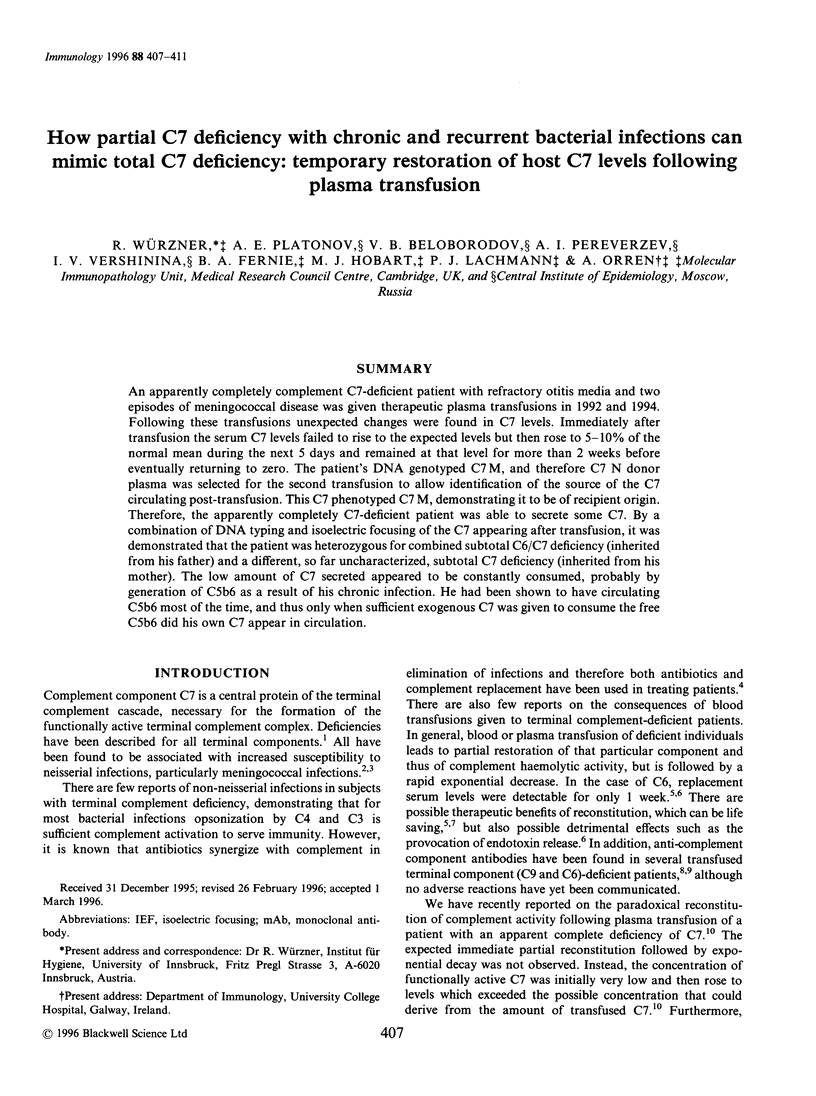
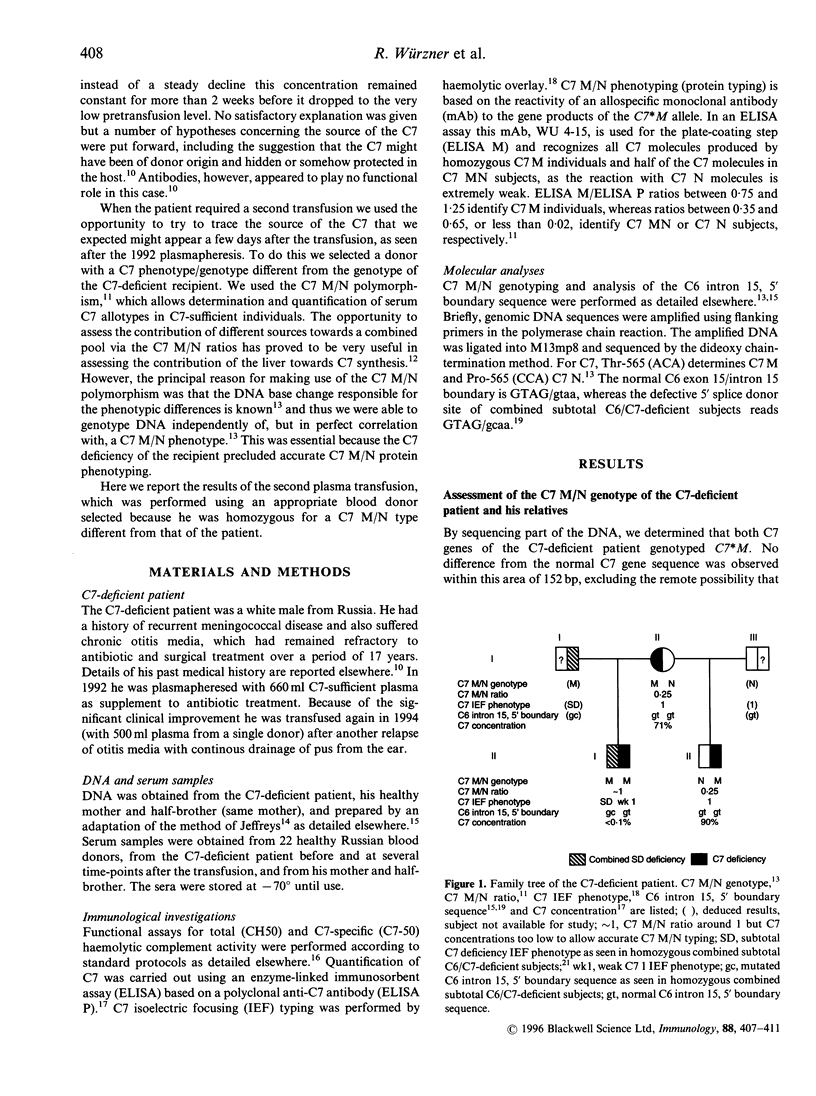
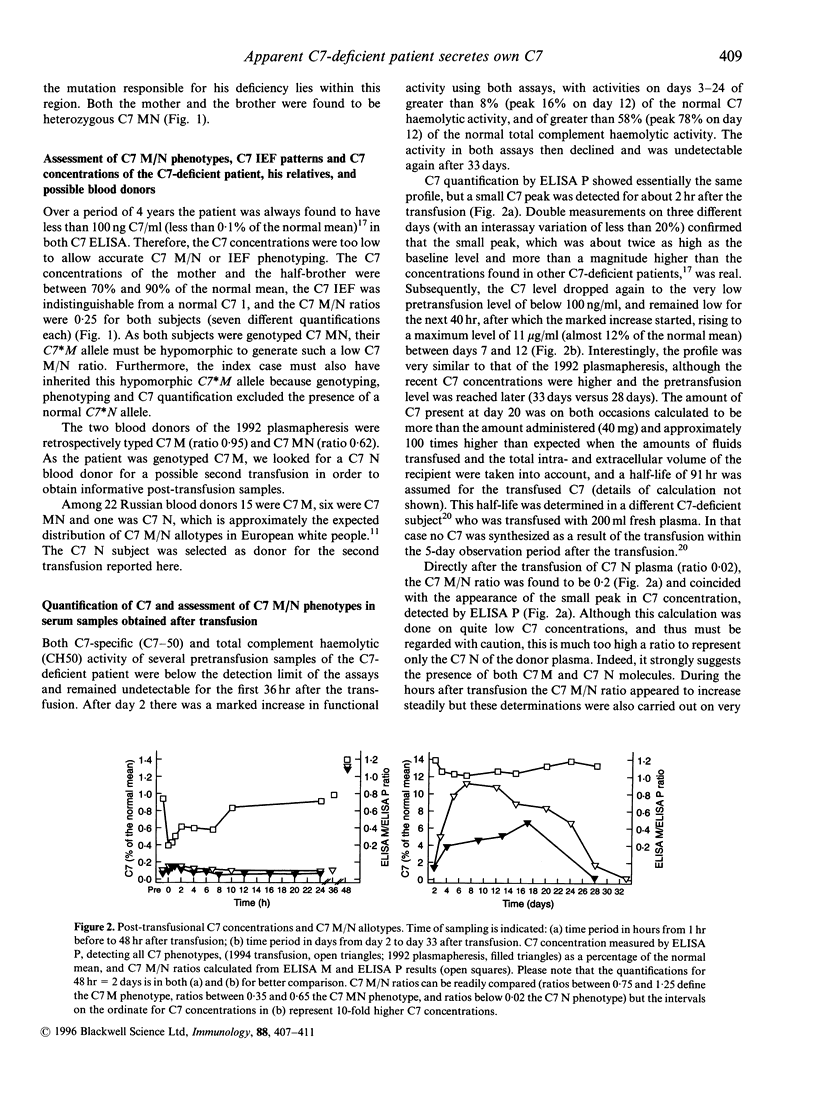
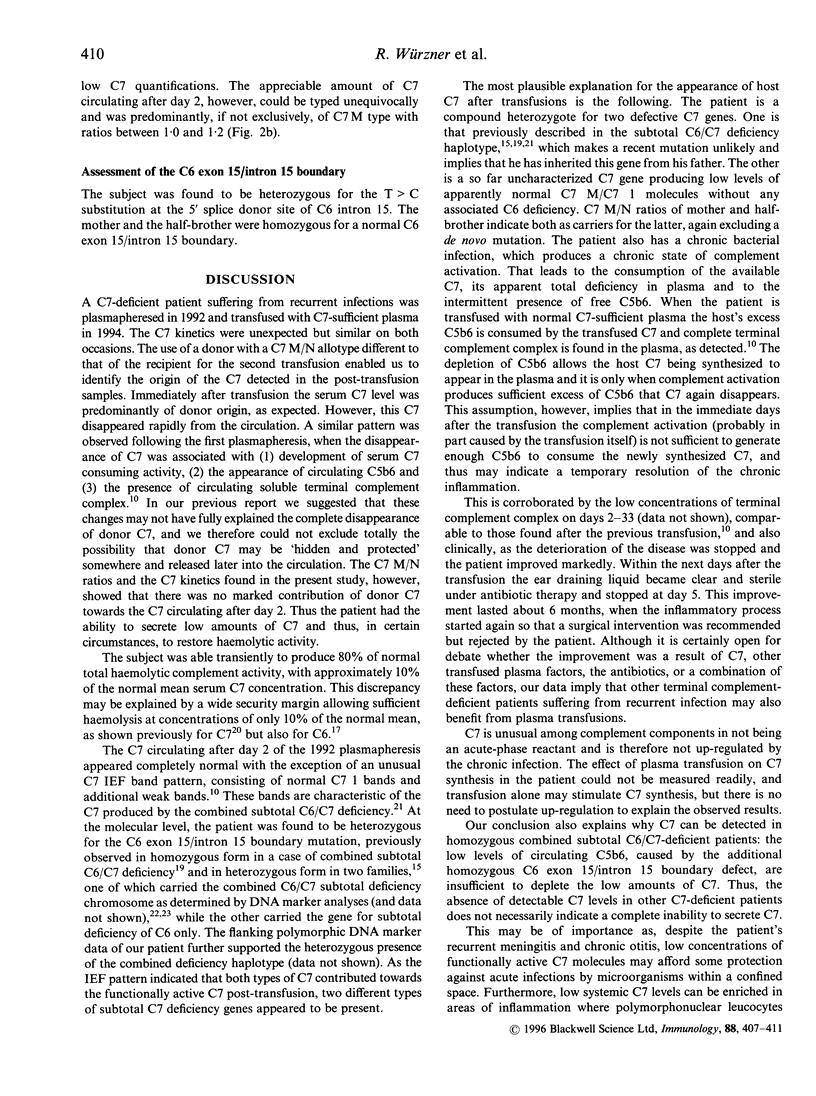
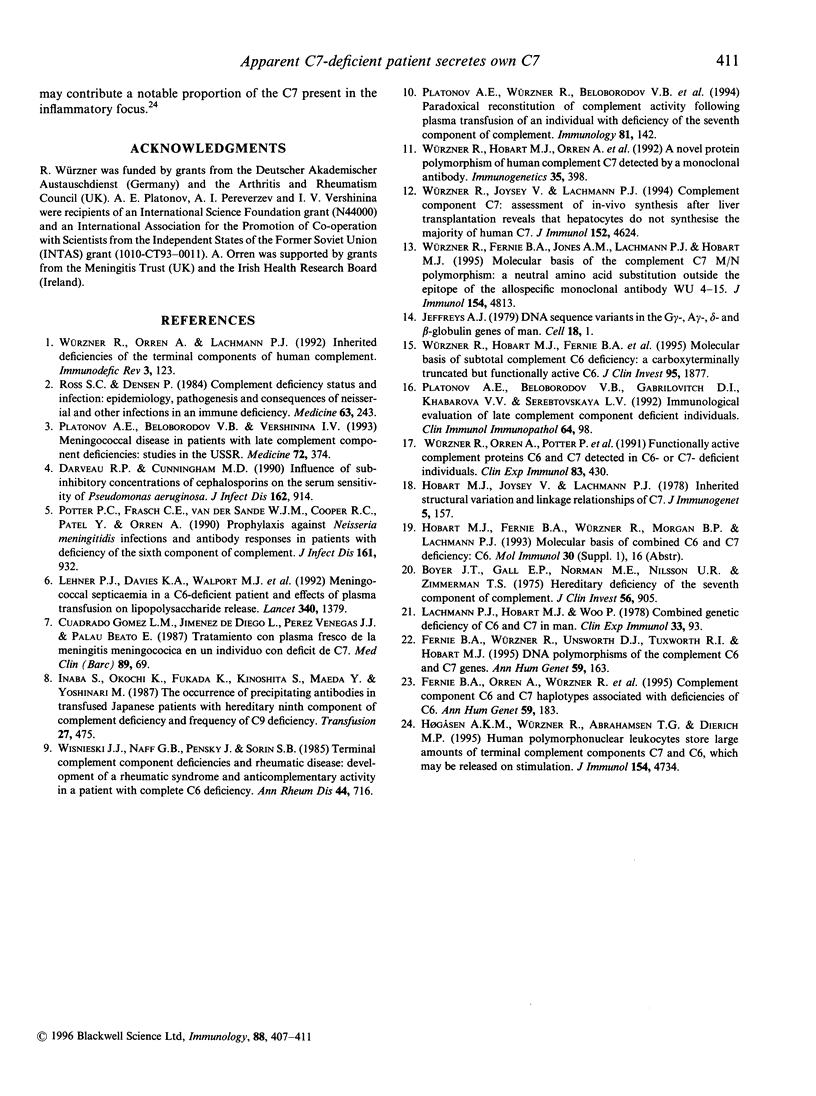
Selected References
These references are in PubMed. This may not be the complete list of references from this article.
- Boyer J. T., Gall E. P., Norman M. E., Nilsson U. R., Zimmerman T. S. Hereditary deficiency of the seventh component of complement. J Clin Invest. 1975 Oct;56(4):905–913. doi: 10.1172/JCI108170. [DOI] [PMC free article] [PubMed] [Google Scholar]
- Darveau R. P., Cunningham M. D. Influence of subinhibitory concentrations of cephalosporins on the serum sensitivity of Pseudomonas aeruginosa. J Infect Dis. 1990 Oct;162(4):914–921. doi: 10.1093/infdis/162.4.914. [DOI] [PubMed] [Google Scholar]
- Fernie B. A., Orren A., Würzner R., Jones A. M., Potter P. C., Lachmann P. J., Hobart M. J. Complement component C6 and C7 haplotypes associated with deficiencies of C6. Ann Hum Genet. 1995 Apr;59(Pt 2):183–195. doi: 10.1111/j.1469-1809.1995.tb00740.x. [DOI] [PubMed] [Google Scholar]
- Fernie B. A., Würzner R., Unsworth D. J., Tuxworth R. I., Hobart M. J. DNA polymorphisms of the complement C6 and C7 genes. Ann Hum Genet. 1995 Apr;59(Pt 2):163–181. doi: 10.1111/j.1469-1809.1995.tb00739.x. [DOI] [PubMed] [Google Scholar]
- Hobart M. J., Joysey V., Lachmann P. J. Inherited structural variation and linkage relationships of C7. J Immunogenet. 1978 Jun;5(3):157–163. doi: 10.1111/j.1744-313x.1978.tb00641.x. [DOI] [PubMed] [Google Scholar]
- Høgåsen A. K., Würzner R., Abrahamsen T. G., Dierich M. P. Human polymorphonuclear leukocytes store large amounts of terminal complement components C7 and C6, which may be released on stimulation. J Immunol. 1995 May 1;154(9):4734–4740. [PubMed] [Google Scholar]
- Inaba S., Okochi K., Fukada K., Kinoshita S., Maeda Y., Yoshinari M. The occurrence of precipitating antibodies in transfused Japanese patients with hereditary ninth component of complement deficiency and frequency of C9 deficiency. Transfusion. 1987 Nov-Dec;27(6):475–477. doi: 10.1046/j.1537-2995.1987.27688071698.x. [DOI] [PubMed] [Google Scholar]
- Jeffreys A. J. DNA sequence variants in the G gamma-, A gamma-, delta- and beta-globin genes of man. Cell. 1979 Sep;18(1):1–10. doi: 10.1016/0092-8674(79)90348-9. [DOI] [PubMed] [Google Scholar]
- Lehner P. J., Davies K. A., Walport M. J., Cope A. P., Würzner R., Orren A., Morgan B. P., Cohen J. Meningococcal septicaemia in a C6-deficient patient and effects of plasma transfusion on lipopolysaccharide release. Lancet. 1992 Dec 5;340(8832):1379–1381. doi: 10.1016/0140-6736(92)92561-s. [DOI] [PubMed] [Google Scholar]
- Platonov A. E., Beloborodov V. B., Gabrilovitch D. I., Khabarova V. V., Serebrovskaya L. V. Immunological evaluation of late complement component-deficient individuals. Clin Immunol Immunopathol. 1992 Aug;64(2):98–105. doi: 10.1016/0090-1229(92)90186-r. [DOI] [PubMed] [Google Scholar]
- Platonov A. E., Beloborodov V. B., Vershinina I. V. Meningococcal disease in patients with late complement component deficiency: studies in the U.S.S.R. Medicine (Baltimore) 1993 Nov;72(6):374–392. doi: 10.1097/00005792-199311000-00002. [DOI] [PubMed] [Google Scholar]
- Platonov A. E., Würzner R., Beloborodov B., Jones A. M., Troshansky D. V., Vershinina I. V., Lachmann P. J., Orren A. Paradoxical reconstitution of complement activity following plasma transfusion of an individual with deficiency of the seventh component of complement. Immunology. 1994 Jan;81(1):142–148. [PMC free article] [PubMed] [Google Scholar]
- Potter P. C., Frasch C. E., van der Sande W. J., Cooper R. C., Patel Y., Orren A. Prophylaxis against Neisseria meningitidis infections and antibody responses in patients with deficiency of the sixth component of complement. J Infect Dis. 1990 May;161(5):932–937. doi: 10.1093/infdis/161.5.932. [DOI] [PubMed] [Google Scholar]
- Ross S. C., Densen P. Complement deficiency states and infection: epidemiology, pathogenesis and consequences of neisserial and other infections in an immune deficiency. Medicine (Baltimore) 1984 Sep;63(5):243–273. [PubMed] [Google Scholar]
- Wisnieski J. J., Naff G. B., Pensky J., Sorin S. B. Terminal complement component deficiencies and rheumatic disease: development of a rheumatic syndrome and anticomplementary activity in a patient with complete C6 deficiency. Ann Rheum Dis. 1985 Oct;44(10):716–722. doi: 10.1136/ard.44.10.716. [DOI] [PMC free article] [PubMed] [Google Scholar]
- Würzner R., Fernie B. A., Jones A. M., Lachmann P. J., Hobart M. J. Molecular basis of the complement C7 M/N polymorphism. A neutral amino acid substitution outside the epitope of the allospecific monoclonal antibody WU 4-15. J Immunol. 1995 May 1;154(9):4813–4819. [PubMed] [Google Scholar]
- Würzner R., Hobart M. J., Fernie B. A., Mewar D., Potter P. C., Orren A., Lachmann P. J. Molecular basis of subtotal complement C6 deficiency. A carboxy-terminally truncated but functionally active C6. J Clin Invest. 1995 Apr;95(4):1877–1883. doi: 10.1172/JCI117868. [DOI] [PMC free article] [PubMed] [Google Scholar]
- Würzner R., Hobart M. J., Orren A., Tokunaga K., Nitze R., Götze O., Lachmann P. J. A novel protein polymorphism of human complement C7 detected by a monoclonal antibody. Immunogenetics. 1992;35(6):398–402. doi: 10.1007/BF00179797. [DOI] [PubMed] [Google Scholar]
- Würzner R., Joysey V. C., Lachmann P. J. Complement component C7. Assessment of in vivo synthesis after liver transplantation reveals that hepatocytes do not synthesize the majority of human C7. J Immunol. 1994 May 1;152(9):4624–4629. [PubMed] [Google Scholar]
- Würzner R., Orren A., Lachmann P. J. Inherited deficiencies of the terminal components of human complement. Immunodefic Rev. 1992;3(2):123–147. [PubMed] [Google Scholar]
- Würzner R., Orren A., Potter P., Morgan B. P., Ponard D., Späth P., Brai M., Schulze M., Happe L., Götze O. Functionally active complement proteins C6 and C7 detected in C6- and C7-deficient individuals. Clin Exp Immunol. 1991 Mar;83(3):430–437. doi: 10.1111/j.1365-2249.1991.tb05656.x. [DOI] [PMC free article] [PubMed] [Google Scholar]


